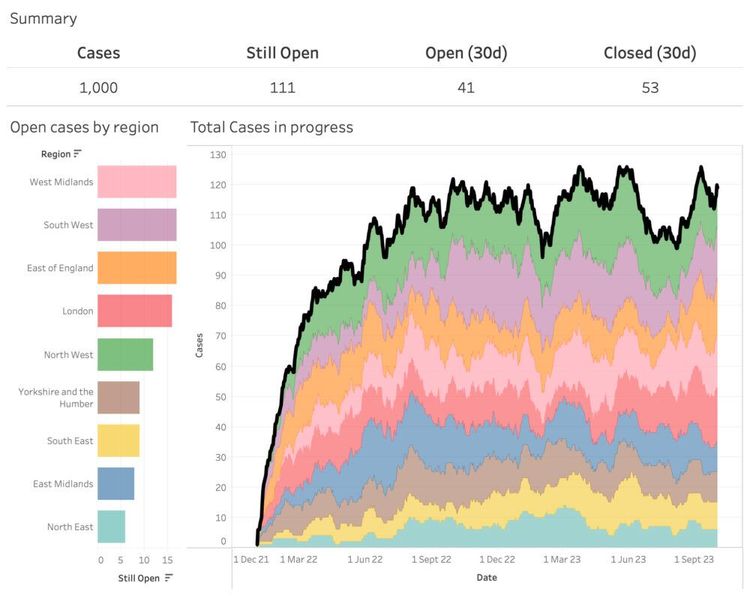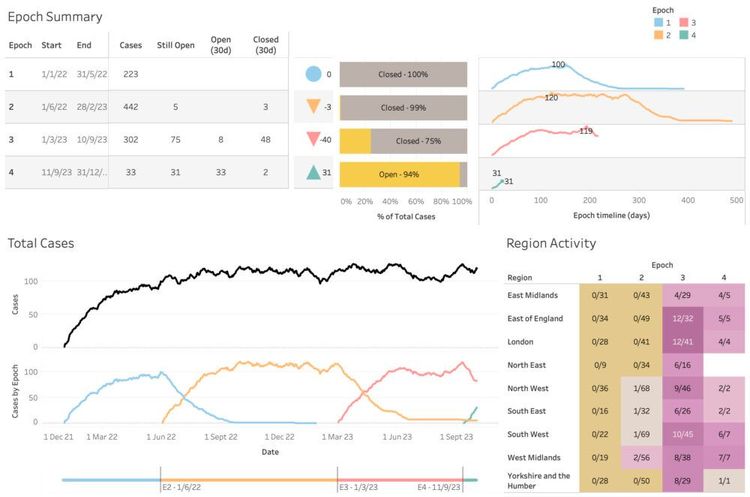In various industries, tracking open cases, or items—such as support tickets, overdue invoices, or waiting lists for medical treatments—is a common practice for business analysis and reporting. Traditional reporting methods usually focus on presenting real-time numbers, like the count of open support tickets, perhaps alongside a count of tickets opened and closed in the last 30 days and other similar performance metrics. For example, a dashboard may show that 100 support tickets are currently open and that this is pretty steady over time, or may be trending up a little or down a little and thus does represent in a way the workload for the support team. However, this traditional approach often lacks a sense of progress for workers, as new cases continually replace the ones they resolve leading to a frustrating lack of perceived progress for teams. To address this issue, introducing the concept of “epochs” into data analysis can significantly improve both morale and operational efficiency.

Normally, the term “epoch” conjures up notions of fixed, often historical, periods. However epochs can serve as dynamic, flexible data segmentation that offer significant advantages. An “epoch” is a designated period or a capped data set that allows for better control over work in progress. Once the epoch is set—based on a specific date or an upper limit of open cases—the data set is ‘frozen’ for that epoch. Any new cases after the epoch cut-off date will belong to the next epoch.
Segregating the data in this way can bring several advantages – Team members can actually see the number of open items decrease in their epoch, which can give a sense of real progress over the traditional method described above and can be a significant morale booster. Epochs can also allow for better resource allocation and focused strategies, as one team can aim to close out a closed epoch and another can focus on reducing the growth in the open one.

There are many real-world examples where the use of epochs in this way could present data in a new light and drive better actions and understanding of the efforts delivered to process the work.
Healthcare: Waitlist Management
In the UK, NHS waiting lists have been an issue of concern for a long time. Utilising epochs could add a dynamic element to managing and presenting the data of waiting lists. For example, an epoch might end when a particular treatment becomes available, or a change in management (or even government policy) occurs. Another epoch might commence purely based on when the waiting list reaches a certain level. Such dynamic epochs allow healthcare providers to adapt to resource availability, ensure equitable care distribution, and assist in prioritising those waiting the longest accordingly. Publishing data in this manner could also improve the public’s perception of management of lists – i.e. when people see that a particular epoch of patients is being effectively managed and treated, it can help build that public trust.
Financial Services: Risk Assessment and Loan Applications
In financial services, epochs can be defined by risk thresholds. A bank might set an epoch to close when some milestone event occurs, such as the aggregate risk from open loan applications reaches a particular limit. This would trigger an in-depth analysis of the current risk portfolio before proceeding to a new epoch. Alternatively, the epoch might end when a specific number of applications have been approved, serving as a dynamic way to manage workload and risk.
Manufacturing: Production Cycles
In manufacturing, epochs could be aligned with production cycles. For example, an epoch might end when enough raw materials for a particular batch have been sourced. Alternatively, the epoch could close upon the completion of a quality control check, signalling the readiness for the next production cycle.
Incorporating epochs into your data analysis and reporting framework can yield numerous benefits, from improving team morale to enabling a more focused strategy for tackling “open” items or “work in progress” measurements. By converting endless streams of new cases into manageable chunks, epochs provide a concrete path toward measurable accomplishments. Epochs can be used tied to specific time periods but do not have to be. They can allow for a more nuanced understanding and actionable insights in diverse fields such as healthcare, financial services, and manufacturing.
Parts of this blog post were written with GenAI tools.
